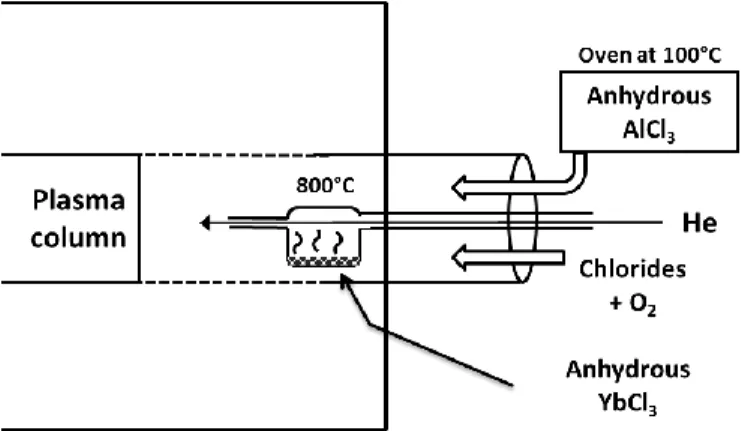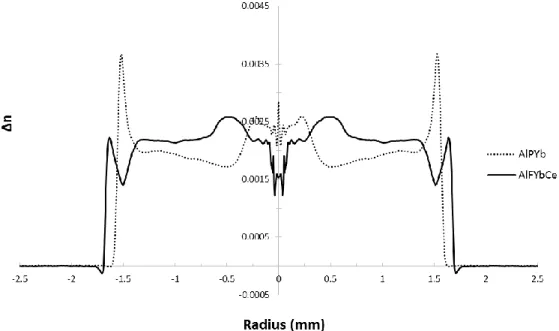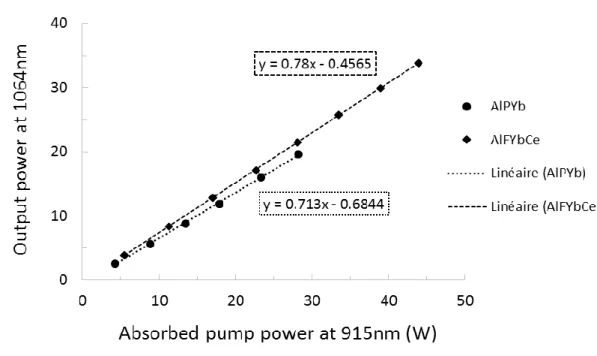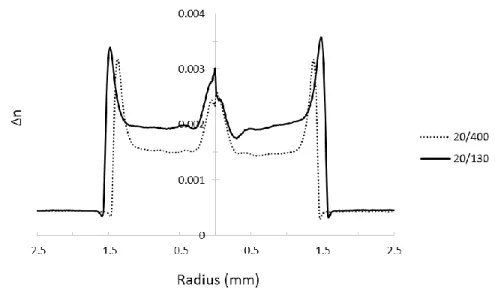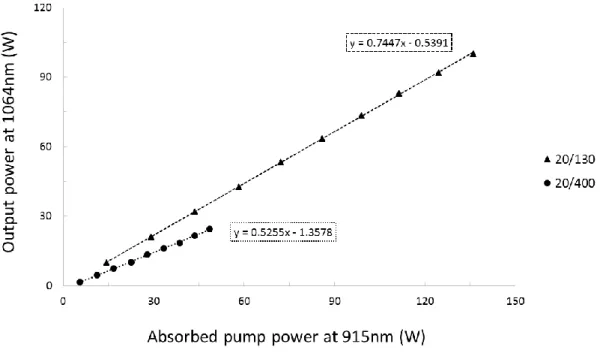HAL Id: hal-02327630
https://hal.archives-ouvertes.fr/hal-02327630
Submitted on 22 Oct 2019
HAL is a multi-disciplinary open access
archive for the deposit and dissemination of
sci-entific research documents, whether they are
pub-lished or not. The documents may come from
teaching and research institutions in France or
abroad, or from public or private research centers.
L’archive ouverte pluridisciplinaire HAL, est
destinée au dépôt et à la diffusion de documents
scientifiques de niveau recherche, publiés ou non,
émanant des établissements d’enseignement et de
recherche français ou étrangers, des laboratoires
publics ou privés.
Towards Large-Mode-Area fibers fabricated by the full
vapor-phase SPCVD process
Alexandre Barnini, Thierry Robin, Daniel Caurant, Thierry Gotter, Gérard
Aka, Cedric Guyon, Pascal Guitton, Ronan Montron, Arnaud Laurent
To cite this version:
Alexandre Barnini, Thierry Robin, Daniel Caurant, Thierry Gotter, Gérard Aka, et al.. Towards
Large-Mode-Area fibers fabricated by the full vapor-phase SPCVD process. Photonics West 2018,
Jan 2018, San Francisco, United States. �hal-02327630�
Towards Large-Mode-Area fibers fabricated by the full vapor-phase
SPCVD process
Alexandre Barnini*
a,b, Thierry Robin
a, Daniel Caurant
b, Thierry Gotter
a, Gérard Aka
b, Cédric
Guyon
b, Pascal Guitton
a, Ronan Montron
a, Arnaud Laurent
aa
iXblue photonics, Rue Paul Sabatier, Lannion, 22300, France;
bInstitut de Recherche de Chimie
Paris (IRCP), 11 rue Pierre et Marie Curie, Paris, 75005, France.
ABSTRACT
Large-Mode-Area (LMA) fibers are key elements in modern high power fiber lasers operating at 1 µm. LMA fibers are highly ytterbium-doped and require a fine control of the core refractive index (RI) close to the silica level. These low RI have been achieved with multi-component materials elaborated using a full-vapor phase Surface Plasma Chemical Vapor Deposition (SPCVD) process, enabling the fabrication of large core diameter preforms (up to 4 millimeters). Following the technology demonstration, presented in Photonics West 2017, with results on 10/130 (core-to-clad diameters (in µm) ratio) fibers, this paper aims to present updated results obtained for double-clad 11/130, 20/130 and 20/400 LMA fibers, with numerical apertures at, respectively, 0.08 and 0.065. The study is based on aluminosilicate core material co-doped either with fluorine or phosphorus to achieve optimal radial RI tailoring. The fiber produced exhibit low background losses (<20dB/km at 1100nm) and high power conversion efficiencies, up to 74% for output powers of 100W limited by our test setup. The Gaussian beam quality has been evaluated using the M² measurement. Photodarkening behavior will be discussed for both fluorine and phosphorus-doped aluminosilicate materials and particularly the use of cerium as co-dopant. The SPCVD technology can indeed be used for the production of Yb-doped LMA fibers. Current development is now focused on other rare-earth doped fibers.
Keywords: Rare earth-doped fiber, ytterbium, optical amplifier, laser, aluminosilicate fibers, large-mode-area fibers and photodarkening.
*alexandre.barnini@alumni.chimie-paristech.fr; phone +33687138723; www.ixblue.com and www.ircp.cnrs.fr
1. INTRODUCTION
Since the first demonstration of a laser emission in 1960 by T. Maiman1, lasers represent a major lever of the scientific progress in the photonic world. They enabled the rise of new technolo447 2802gical applications in various fields: materials cutting2 and welding, medicine3 and defense4. Fiber laser technologies have been first put aside by intense activities on crystal or gas lasers. After the fabrication of a first low-attenuation neodymium-doped-silica optical fiber core and its use as a laser cavity in the nineties5, research and development on fiber lasers have intensively grown. The large ratio of surface-to-active volume of optical fibers led to excellent heat dissipation6 and a good spatial distribution of the signal, resulting in nearly Gaussian beams and higher stability7. Ytterbium-doped silica with double-clad design are currently widely used for high power applications. Silica is of great interest as a host for ytterbium ions (and more generally for rare earth (RE) ions), because it leads to a broadening of the RE ion emission and absorption spectra compared to the similar crystal host, and consequently enables a more efficient optical pumping8 (at around 915 or 976nm in the case of ytterbium-doped optical fiber cores). Nowadays, tendency is to continuously increase output powers. When the power extracted from the fiber increases, deleterious non-linear effects are observed. In order to push their appearance threshold back, smaller lengths of fibers are used, and therefore core diameters are increased to lower the optical density. Finally, the refractive index (RI) of the core is decreased close to the clad RI in order to keep an almost single mode signal. These high power-tailored optical fibers are commonly named as large-mode-area (LMA) fibers.
In a previous paper9, we have presented an innovative process named Surface Plasma Chemical Vapor Deposition (SPCVD) and we have suited it to the fabrication of fibers with 10µm core diameters and compositions (SiO2-Al2O3
-Yb2O3-F) that were not accessible with the standard MCVD process, while precisely controlling the dopant incorporation
both radially and between consecutive preforms. In this paper, we present our latest results on 11µm core diameter fibers and on 20µm LMA fibers synthesized using our custom-made SPCVD process. Fibers of various core compositions (SiO2-Al2O3-Yb2O3-F and SiO2-Al2O3-P2O5-Yb2O3) are studied regarding their attenuation, their power conversion
efficiency and their resistance to photodarkening.
2. PREFORM FABRICATION
2.1 Presentation of the SPCVD process
First described by Pavy et al. in 198610, the SPCVD process was used for the production of telecommunication single mode fibers. The technology is based on a low-pressure microwave (2.45GHz) plasma used to dissociate a mixture of chloride, Freon gases and oxygen, in order to generate oxidation reactions at the inner surface of a synthetic silica tube. The tube is placed at the center of a tubular furnace heated at about 1100°C in order to get a vitrified deposit. By positioning the silica substrate tube under vacuum conditions, the ignition of a microwave discharge is possible. The microwaves propagate along the inner surface of the dielectric substrate tube thus supporting the plasma column: the plasma is self-sustained. But the amplitude of the electromagnetic field decreases from the point of application of the plasma to the end of the column, and so does the concentration of electrons. The plasma column subsists only above a critical concentration of 4.31x1011 electrons.cm-3, 11. The reagents used in this paper for the deposits are: SiCl4, AlCl3,
YbCl3, P2O5, CeCl3 and C2F6. The deposit takes place on the first centimeters of the plasma column (Fig. 1). Since the
microwave power applied dictates the length of the plasma column, by modulating this power, the deposit area can be shifted forward and backward in order to get a total length of deposit of several hundred millimeters. The plasma scanning frequency used in our experiments is 0.5Hz and we successfully synthesized a vitrified deposition of 400mm length in a 16x20mm (IDxOD) tube, where each glassy layer deposited has a thickness of several tenths of nanometers.
2.2 Evaporation of aluminum and rare earth chlorides
We use 5N purity anhydrous aluminum chloride (AlCl3) as a precursor for aluminum, and the reagent is placed into a
silica reactor. By heating the precursor in an oven at 100°C at around 1mbar, the vapors are generated and carried out to the plasma reaction area by way of an inert gas. A high temperature mass flow controller is located in the oven in order to properly control the amount of aluminum delivered to the reaction zone to ensure repeatable layer composition.
We use 4N purity anhydrous ytterbium and anhydrous cerium chlorides as precursors for ytterbium and cerium respectively. The reagents are placed into two quartz reactors located close to the reaction zone (Fig.2). The temperature of each reactor is controlled independently. By heating the precursors at around 800°C and 1mbar, the vapors are generated and carried out to the plasma reaction area by way of an inert gas. A great care has been taken to design the reactor such as to prevent any gas (and especially oxygen) to come into contact with the rare earth chloride powders during the deposition time. A simplified set-up (with only the evaporation of ytterbium chloride) is presented in Fig. 2.
3. PREFORM AND FIBER CHARACTERIZATIONS
3.1 Refractive index and chemical composition
The refractive index profiles (RIP) of the cores have been obtained using a PK2600 (Photon Kinetics) preform analyzer, scanning the preform both radially and longitudinally with a He-Ne light beam at 633nm.
The chemical composition of the cores has been analyzed using an electron microprobe Cameca SX100 (15kV, 50nA), at the CAMPARIS department of the Pierre et Marie Curie University. The analysis has been made on slices of the preform, previously polished and metallized.
3.2 Attenuation
The attenuations of the cores presented in this work have been measured at 1310nm using the well-known Optical Time Domain Reflectometry method.
3.3 Power conversion efficiency and M² coefficient
In order to test our Yb-doped active cores synthesized by the SPCVD process, we used the laser cavity set-up presented in Fig. 3. Up to six 30W multimode pump diodes were used to inject power at 915nm in the double-clad Yb-doped fiber under test. The power of each multimode pump diode is first combined in a passive double-clad fiber through a pump combiner (LasFiberio). The Yb-doped fiber under test is spliced between two fiber Bragg gratings, Rmax and Rmin (made
at iXblue photonics). Rmax reflects more than 99% of the laser signal at 1064nm (and delivers 98.5% of the pump signal
at 915nm) whereas Rmin reflects around 9% of this signal, which enables to create a continuously-pumped laser cavity.
The power conversion efficiency (PCE) is defined as the ratio between the output power at 1064nm and the absorbed pump power at 915nm.
For the evaluation of the laser beam quality, the M² parameter is measured and enables to quantify the deviation of the emitted beam from a perfect Gaussian beam (M²=1.0). The emitted beam at the output of the laser cavity is then focused on a beam analyzer (Ophir).
Figure 4: Set-up for the evaluation of the photodarkening
3.4 Evaluation of photodarkening phenomenon
Photodarkening (PD) is a well-known detrimental effect in aluminosilicate ytterbium-doped optical fiber12 impeding fiber laser lifetime. It can be appreciatively reduced by co-doping with cerium13 in aluminosilicate fibers or using a phosphosilicate14 or an aluminophosphosilicate15 core composition with an equimolar Al/P atomic ratio.
We measured PD using a classic setup by core-pumping a short length of fiber at 976nm and measuring the fiber transmission at 635nm (Fig. 4). Indeed, it is known that colored-centers appear due to the pump signal and lead to strong absorption bands below 700nm16.
4. RESULTS
The characterizations and results on our SPCVD-made fibers are presented in two parts. The first one focuses on fibers with 11µm core diameter and 130µm clad diameter, and the second one on larger core diameter fibers (20µm).
4.1 Characterizations of the 11/130 fibers
Following the work of our previous paper9, the results on two fibers are presented here. The compositions of the cores are different: the first one, SiO2-Al2O3-Yb2O3-Ce2O3-F, is called AlFYbCe and the second one, SiO2-Al2O3-P2O5-Yb2O3,
not studied previously, is called AlPYb. In order to successfully incorporate both aluminum and phosphorus with a vapor
phase process, one has to be careful not to mix gaseous AlCl3 and POCl3, because they react together to create an
unwanted complex17, which condensates before the reaction zone.
4.1.1 Preform characterizations
Figure 5 shows the RIP of the AlPYb and AlFYbCe cores made by the full vapor phase SPCVD. Both exhibit >3mm diameter cores with a slight inhomogeneity both on the sides and at the center (≈1mm) of the profiles. The mean refractive indexes of the AlFYbCe and AlPYb cores are respectively 2.30 and 2.20x10-3. The average measured composition of the dopants in both cores is given in table 1. Aluminum and ytterbium concentrations are almost the same in the two cores.
% molar atomic Al Yb F P Ce
AlFYbCe 1.25 0.11 1.0 0 0.02
AlPYb 1.33 0.11 0 1.28 0
Table 1: Composition of the AlFYbCe and AlPYb cores
Two octagonal double-clad fibers with an 11/130 core-to-clad ratio and a core numerical aperture of 0.08 have been drawn from those preforms and are characterized in the following sections. The octagonal geometry was chosen so that the fibers could be easily tested with on the shelf components.
4.1.2 Fiber characterizations
In a first step, the fibers have been characterized in terms of core attenuation at 1310nm. The results are presented in table 2, where the drawing tension is noticed.
Numerical aperture Drawing tension (g) Attenuation at 1310nm (dB/km)
AlFYbCe 0.085 82 25.3
AlPYb 0.081 101 64.9
Table 2: Attenuation at 1310nm of the AlFYbCe and AlPYb cores
The drawing tension of our AlFYbCe fibers has been optimized in order to lower the attenuation at 1310nm down to 25.3dB/km, which is currently the lowest obtained for this core composition. The AlPYb core composition has been developed more recently, therefore the drawing tension is not optimized, but led to a 64.9dB/km attenuation at 1310nm which is compatible with the production of double clad fibers. The numerical aperture of both fibers is close to 0.08. RI measurement using our InterFiber Analysis IFA-100 optical fiber analyzer on these fibers did not show significant modification induced by the drawing phase indicating that no major diffusion mechanism takes place during the drawing process.
AlFYbCe and AlPYb fibers exhibit respectively a multimode pump absorption of 1.35 and 1.31dB/m at 915nm. The PCE, corresponding to the ratio of the cavity output power at 1064nm versus the absorbed pump power at 915nm, is given in Fig. 6. It was measured at 78% up to 44W of pump power for a 7.5m long piece of AlFYbCe fiber, and at 71.3% up to 28W for a 8m long piece of AlPYb fiber. These results are in line with the state of the art of similar core compositions made by other processes18. Moreover, the M² parameter has been measured at 1.06 for the AlFYbCe fiber and at 1.20 for the AlPYb fiber, at an output power around 3.8W.
The photodarkening phenomenon has been evaluated by core-pumping at 976nm around 10mm long of each fibers during 1000min, and the results are given in Fig. 7. We observe that the attenuation penalty at 635nm of each core remains low (only ≈26dB/m), compared to the SPCVD-made AlFYb fiber without cerium, whose attenuation keeps increasing. This result shows the major role of cerium to mitigate photodarkening in AlFYb cores compositions, but also the appreciated property of AlPYb cores compositions with an equimolar Al/P ratio to mitigate photodarkening without the need to incorporate cerium15.
Finally, the 11/130 Yb-double clad fibers made by SPCVD exhibit good lasing properties with high PCE: 71.3 and 78.0% for AlPYb and AlFYbCe fibers respectively. The M² parameters are close to 1.0, especially for the AlFYbCe fiber (M²=1.06). Moreover, both fibers are photodarkening-resistant even though a small content of cerium is needed in the composition of AlFYb cores. We believe that the lasing properties can be improved by adding particularly a small
content of germanium to the composition in order to reduce the attenuation of our rare earth-doped cores, as already demonstrated in the litterature19.
The next section of this paper focus on fiber characterizations of AlFYbCe fibers with 20µm core diameters.
4.2 Characterizations of LMA fibers with 20µm core diameter
We present here the characterizations of two LMA fibers with 20µm core diameter. Both fibers have the same core composition: SiO2-Al2O3-Yb2O3-Ce2O3-F, but one has a 130µm clad diameter and is called 20/130, whereas the other
one has a 400µm clad diameter and is called 20/400.
Figure 7: Photodarkening measurements on 11/130 AlFYb (dashed line), AlFYbCe (dots) and AlPYb (full line) fibers
4.2.1 Preform characterizations
Figure 8 shows the RIP of the 20/130 and 20/400 preform cores made by the SPCVD process. As for previous RIP (Fig. 5), both exhibit >3mm diameter cores with a slight inhomogeneity on the sides but with a narrower raising of the refractive index at the center of the profiles (≈0.5mm). The average refractive indexes of the 20/130 and 20/400 cores are respectively 2.10 and 1.6x10-3. The average content of the dopants in both cores is given in table 3.
% molar atomic Al Yb F Ce
20/130 1.17 0.10 0.98 0.030
20/400 0.94 0.08 0.95 0.026
Table 3: Composition of the 20/130 and 20/400 cores
Two octagonal double-clad fibers with a 20/130 and a 20/400 core-to-clad ratio and a core numerical aperture of 0.08 and 0.067 respectively have been drawn from those preforms and are characterized in the following sections.
4.2.2 Fiber characterizations
The data given in table 4 present the characteristics of each fiber, where the drawing tension is pointed out. Because of the low NA of the 20/400 fiber, the attenuation at 1310nm couldn’t be evaluated using the OTDR due to excessive bending losses.
Numerical aperture Drawing tension (g) Attenuation at 1310nm (dB/km) Background multimode loss at 1100nm (dB/km) 20/130 0.08 65 63.0 17.8 20/400 0.067 139 Non-measured 4.5
Table 4: Characteristics of the 20/130 and 20/400 cores
As previously mentioned, RI measurement on these fibers did not show any significant modification induced by the drawing process from the preform-measured RI.
20/130 and 20/400 cores exhibit respectively a multimode absorption of 3.31 and 0.37dB/m at 915nm, therefore 3.9m long piece of 20/130 fiber and 27.0m long piece of 20/400 fiber have been used to evaluate the PCE, whose results are presented in Fig. 9.
The maximum injected pump power for the 20/130 fiber is 136W, at which was obtained an output power at 1064nm of 100W and led to a PCE of 74.5%. The injected power is only limited by the number of available pump diodes, and it would be very interesting to test the fiber at higher powers. The M² parameter has been measured at 1.53 for this fiber at an output power of 10W. On the other hand, the injected pump power for the 20/400 fiber was limited to only 48W, and we obtained an output power of 24.5W. The measured PCE is around 53%, and the M² parameter has been measured at 1.03 for this fiber at an output power of 10W.
We believe that the PCE on this first version of an SPCVD-made 20/400 LMA fiber will be improved through splice process optimization. We did observe significant heating at the splice locations in our set-up and splice loss measurements were performed and confirmed unusually high signal losses. We are confident that the core quality is not the cause of the low PCE because equivalent composition cores yielded good lasing properties when used as 11/130 geometry type fibers. Furthermore, we measured some equivalent 20/400 fibers available on the market with our PCE test set-up and found similar values. Process improvement on splicing 400µm diameter fibers is ongoing, and updated results will be presented at the conference. Conversely, fibers with a 130µm clad diameter are regularly spliced and well handled, which can explain the high PCE obtained with the 20/130 fiber for such powers.
Furthermore, the photodarkening has not been evaluated yet on 20/130 and 20/400 fibers, but we do not expect any different behavior from the 11/130 AlFYbCe fiber, because the core composition is similar.
5. CONCLUSIONS
In this work, we have demonstrated the capability of the SPCVD process to produce various complex core compositions, that is to say SiO2-Al2O3-Yb2O3-Ce2O3-F and SiO2-Al2O3-P2O5-Yb2O3. We have successfully drawn these preforms into
fibers suited for moderate and high power lasers. The 11/130 AlFYbCe and AlPYb fibers have exhibited high PCE over 71% for output powers around 30W, with M² parameters close to 1. Photodarkening has been mitigated in both compositions, using a small content of cerium for the AlFYb core. The 20/130 fiber has also shown an excellent PCE of 74.5% for high powers up to 100W, unlike the 20/400 fiber whose measured PCE is rather low (53%), probably due to non-optimized splicing process for these large diameter fibers. Future work focuses on synthesizing new core compositions for 20/130 and 20/400 fibers and on improving the characterizations of these fibers, but also on studying other rare earth ions.
REFERENCES
[1]: Maiman, T.H., “Stimulated optical radiation in ruby”. Nature, 187, 493-494 (1960).
[2]: Carter R.M., Throughton M., Chen J., Elder I., Thomson R.R., Esser M.J.D., Lamb R.A. and Hand D.P., “Towards industrial ultrafast laser microwelding: SiO2 and BK7 to aluminum alloy”. Appl. Opt. 56(16), 4873-4881 (2017).
[3]: Lefort C., “A review of biomedical multiphoton microscopy and its laser sources”. J. Phys. D, 50(42), 423001- 423026 (2017).
[4]: Qu Z., Li Q., Meng H., Sui X., Zhang H. and Zhai X., “Application and the key technology on high power fiber- optic laser in laser weapon”. Proc. SPIE 9294, 92940C-1-92940C-5 (2014).
[5]: Poole S.B., Payne D.N. and Fermann M.E., “Fabrication of low-loss optical fibers containing rare earth ions”. Electron. Lett., 21(17), 738-740 (1985).
[6]: Tünnermann A., Schreiber T., Röser F., Liem A., Höfer S., Zellmer H., Nolte S and Limpert J., “The renaissance and bright future of fibre lasers,” J. Phys. B: At. Mol. Opt. Phys. 38, S681–S693 (2005).
[7]: Zervas M.N. and Codemard C.A., “High power fiber lasers: A review,” IEEE J. Sel. Top. Quantum Electron. 20(5), 219-241 (2014).
[8]: Jackson S.D., “Towards high-power mid-infrared emission from a fibre laser,” Nature Photon., 6, 423-431 (2012). [9]: Barnini A., Robin T., Cadier B., Aka G., Caurant D., Gotter T., Guyon C., Pinsard E., Guitton P., Laurent A. and
Montron R., “Rare earth-doped optical fiber core deposition using full vapor-phase SPCVD process”. Proc. SPIE 10100, 101000D-1-101000D-10 (2017).
[10]: Pavy D., Moisan M., Saada S., Chollet P., Leprince P. and Marrec J., “Fabrication of optical fiber preforms by a new surface-plasma CVD process,” Proc. of 12th ECOC, (Barcelona-Spain), 19-22 (1986).
[11]: Golant K.M., “Bulk silicas prepared by low pressure plasma CVD: formation of structure and point defects,” in Pacchioni G., Skuja L. and Griscom D., [Defects in SiO2 and related dielectrics: Science and technology], Kluwer
Academic Publishers, Printed in The Netherlands, 427-452 (2000).
[12]: Koponen J., Söderlund M., Hoffman H., Kliner D. and Koplow J., “Photodarkening measurements in large mode area fibers,” Proc. SPIE 6453, 64531E-1-64531E-11 (2006).
[13]: Engholm M., Jelger P., Laurell F. and Norin L., “Improved photodarkening resistivity in ytterbium-doped fiber lasers by cerium co-doping,” Opt. Lett., 34(8), 1285-1287 (2009).
[14]: Le Guerroue F., Gotter T., Le Masson R., Prades S., Ranger C., Robin T. and Cadier B., “Photodarkening in Yb-doped fibers for fiber lasers,” Fiber integrated opt., 28(1), 60-64 (2009).
[15]: Jetschke S., Unger S., Schwuchow A., Leich M. and Kirchhof J., “Efficient Yb laser fibers with low photodarkening by optimization of the core composition”. Opt. Express, 16(20, 15540-15545 (2008).
[16]: Manek-Hönninger I. and Boullet J, “Photodarkening and photobleaching of an ytterbium-doped silica double-clad LMA fiber”. Opt. Express, 15(4), 1606-1611 (2007).
[17]: Birkeneder F., Berg R.W. and Bjerrum N.J., “Raman and NMR studies in the system phosphoryl chloride-aluminum chloride”. Acta Chem. Scand., 47(4), 344-357 (1993).
[18]: Unger S., Schwuchow A., Jetschke S., Reichel V., Leich M., Scheffel A. and Kirchhof J., “Influence of aluminum-phosphorus codoping on optical properties of ytterbium-doped laser fibers”. Proc. SPIE 7212, 72121B-1-72121B-9 (2009).
[19]: Kirchhof J., Unger S., Schwuchow A., Jetschke S. and Knappe B., “Dopant interactions in high power laser fibers”. Proc. SPIE 5723, 261-272 (2005).

